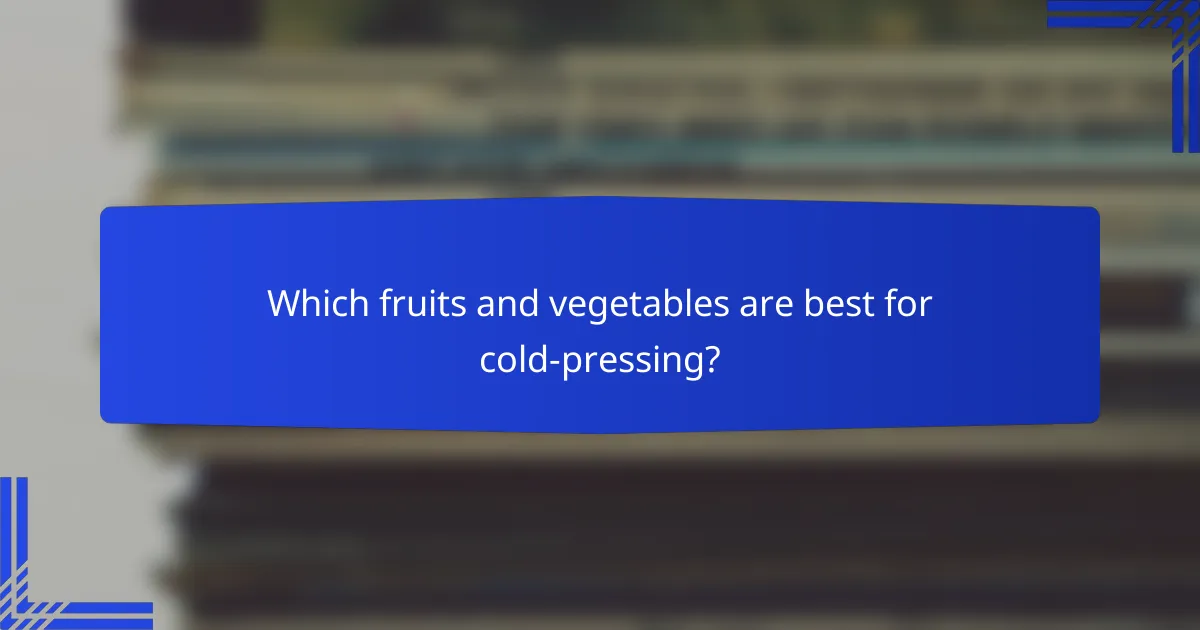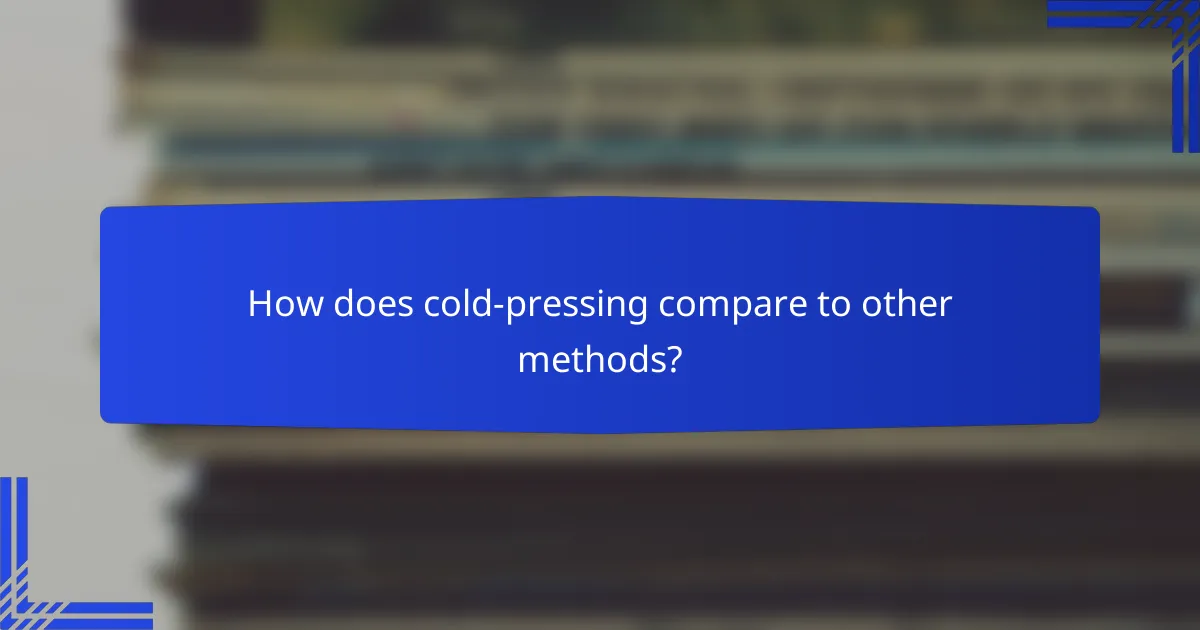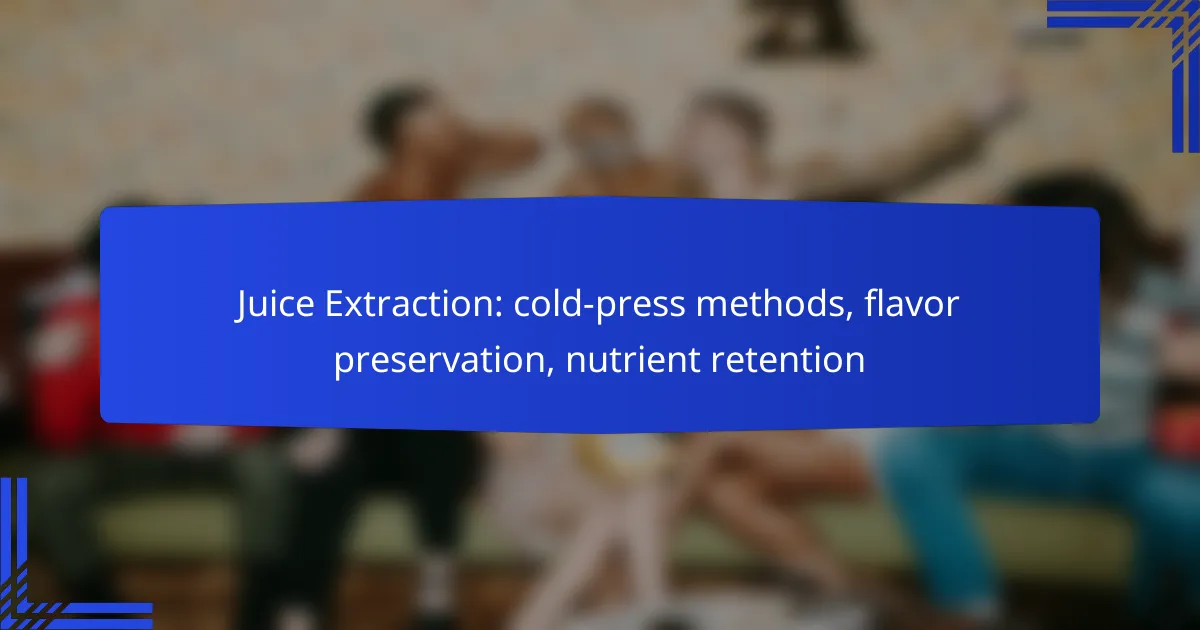Cold-press juice extraction is a method that crushes fruits and vegetables to extract juice without heat, effectively preserving both flavor and nutrients. Utilizing a hydraulic press, this technique minimizes oxidation and ensures a high-quality juice that maintains its natural taste and health benefits. Ideal for water-rich produce like apples, carrots, and leafy greens, cold-pressing results in flavorful and nutrient-dense beverages.

How does cold-press juice extraction work?
Cold-press juice extraction involves crushing fruits and vegetables to extract juice without applying heat, which helps preserve flavor and nutrients. This method typically uses a hydraulic press to apply pressure, resulting in a high-quality juice with minimal oxidation.
Process overview
The cold-pressing process starts with washing and preparing the produce, followed by cutting it into smaller pieces. These pieces are then fed into a hydraulic press, which applies significant pressure to extract juice while keeping the temperature low. This method minimizes exposure to air, reducing oxidation and preserving the juice’s natural qualities.
After extraction, the juice is usually filtered to remove any pulp or solids, resulting in a smooth texture. The final product can be bottled and stored, although it is best consumed fresh to maximize nutrient retention.
Key equipment used
The primary equipment for cold-press juice extraction includes a hydraulic press and a masticating juicer. A hydraulic press is essential for applying the necessary pressure to extract juice efficiently, while a masticating juicer helps break down the produce before pressing.
Additional tools may include cutting boards, knives, and storage containers. Some setups might also feature filtration systems to ensure a clear juice, depending on the desired texture and consistency.
Benefits of cold-pressing
Cold-pressing offers several advantages, including superior flavor and nutrient retention compared to traditional juicing methods. Since the process avoids heat, vitamins and enzymes are preserved, often resulting in juices that contain higher levels of antioxidants and other beneficial compounds.
Moreover, cold-pressed juices typically have a longer shelf life due to reduced oxidation. This method also allows for a wider variety of produce to be used, enabling the creation of unique flavor combinations that appeal to diverse palates.

What are the benefits of cold-press juice?
Cold-press juice offers several advantages, primarily in flavor and nutrient preservation. This method minimizes heat exposure, ensuring that the juice retains its natural taste and health benefits.
Flavor preservation
Cold-press juicing retains the fresh, vibrant flavors of fruits and vegetables better than traditional methods. By avoiding heat and oxidation, the juice maintains its original taste profile, making it more enjoyable to consume.
For instance, cold-pressed orange juice often tastes sweeter and more aromatic compared to juice extracted using centrifugal methods. This flavor retention is crucial for those who prioritize taste in their health beverages.
Nutrient retention
One of the key benefits of cold-press juice is its superior nutrient retention. This method extracts juice while preserving vitamins, minerals, and enzymes that can be lost through heat and oxidation in other juicing processes.
Cold-pressed juices can retain higher levels of vitamin C and antioxidants, which are essential for overall health. For example, leafy greens like kale and spinach maintain more of their nutritional value when juiced cold-pressed compared to traditional techniques.
Health benefits
Drinking cold-pressed juice can contribute to various health benefits, such as improved digestion and enhanced immune function. The high nutrient content supports overall wellness and can aid in detoxification.
Many consumers report feeling more energized and revitalized after incorporating cold-pressed juices into their diets. However, it’s important to consume these juices as part of a balanced diet, as they should complement whole fruits and vegetables rather than replace them.

Which fruits and vegetables are best for cold-pressing?
Fruits and vegetables that are high in water content and natural sugars are ideal for cold-pressing. Common choices include apples, carrots, and leafy greens, which yield flavorful and nutrient-rich juices.
Top choices for flavor
Fruits like oranges, pineapples, and strawberries are excellent for cold-pressing due to their sweetness and vibrant flavors. Vegetables such as cucumbers and bell peppers also add refreshing notes to juice blends. Combining these ingredients can enhance overall taste and create a balanced flavor profile.
When selecting fruits and vegetables, consider seasonal produce for optimal flavor. Fresh, ripe ingredients will yield the best taste, so visit local farmers’ markets or grocery stores that prioritize fresh stock.
Nutrient-rich options
Leafy greens like kale and spinach are packed with vitamins and minerals, making them perfect for nutrient-dense juices. Beets and carrots are also great choices, providing essential nutrients while adding natural sweetness. These options help maximize the health benefits of your juice.
To retain nutrients during the cold-pressing process, avoid exposing the juice to heat or light. Consume the juice shortly after extraction to benefit from the highest nutrient levels, as some vitamins can degrade over time.

How does cold-pressing compare to other methods?
Cold-pressing is a juicing technique that uses hydraulic pressure to extract juice from fruits and vegetables, preserving more flavor and nutrients compared to other methods. This method is often favored for its ability to maintain the integrity of the juice, resulting in a richer taste and higher nutrient retention.
Cold-press vs centrifugal juicing
Centrifugal juicing uses fast-spinning blades to chop and extract juice, which can introduce heat and air, leading to oxidation and nutrient loss. Cold-pressing, on the other hand, operates at lower speeds and temperatures, minimizing oxidation and preserving the juice’s natural flavors and nutrients.
When choosing between these methods, consider that centrifugal juicers are typically faster and more affordable, making them suitable for quick juicing. However, if you prioritize flavor and nutrient retention, cold-press juicing is the better option, albeit at a higher cost and longer extraction time.
Cold-press vs masticating juicing
Masticating juicers, like cold-press juicers, operate at slower speeds and are designed to crush and grind produce, which helps retain nutrients and flavor. However, cold-press juicing often employs a hydraulic press, resulting in higher juice yields and even less oxidation compared to masticating methods.
Both methods excel in nutrient preservation, but cold-pressing generally produces juice with a smoother texture and richer taste. If you’re looking for maximum nutrient retention and flavor, cold-press juicing is a strong choice, while masticating juicers may offer more versatility for different types of produce.

What equipment is needed for cold-press juice extraction?
Cold-press juice extraction requires a specific type of juicer known as a cold-press or masticating juicer. This equipment uses a slow, grinding motion to extract juice from fruits and vegetables while preserving their flavor and nutrients.
Best cold-press juicers in Australia
Some of the top-rated cold-press juicers available in Australia include the Hurom H-AA Slow Juicer, Omega J8226, and Breville BJS600SIL. These models are known for their efficiency in extracting juice while maintaining the integrity of vitamins and minerals.
When choosing a juicer, consider factors such as ease of cleaning, warranty, and customer reviews. Many users prefer models with a low RPM (revolutions per minute) to maximize nutrient retention and flavor preservation.
Cost considerations
The price of cold-press juicers in Australia typically ranges from around AUD 200 to AUD 1,500, depending on the brand and features. Entry-level models are suitable for occasional juicers, while higher-end options offer advanced features and durability for regular use.
When budgeting for a cold-press juicer, factor in additional costs such as maintenance, replacement parts, and ingredients. Investing in a quality juicer can lead to better juice quality and longer-term savings on store-bought juices.

What are the common challenges in cold-press juice extraction?
Cold-press juice extraction faces several challenges, primarily related to juice oxidation, nutrient retention, and flavor preservation. Understanding these issues can help optimize the extraction process and improve the quality of the juice produced.
Juice oxidation
Juice oxidation occurs when the juice is exposed to air, leading to a degradation of flavor and nutrients. This process can diminish the overall quality of the juice, making it less appealing to consumers. To minimize oxidation, it’s essential to limit the juice’s exposure to oxygen during extraction and storage.
One effective method to reduce oxidation is to use airtight containers for storage immediately after extraction. Additionally, some cold-press machines are designed to minimize air contact during the juicing process, which can help preserve the juice’s freshness. It’s also advisable to consume the juice shortly after extraction to enjoy its full flavor and nutritional benefits.
